Onderstaand een mooi stuk over OOPArts gevonden op de site http://beforeitsnews.com/. Ik heb heb er eerder een blog aan besteed nu ik denk was het mijn eerste bericht. Over het boek Eaths forbidden secrets. Het is een digitaal boek over OOPArts die mij anders heeft laten denken, zeker de moeite waard eens te lezen! ►http://thisisyourwake-upcall.blogspot.nl/2009/12/earths-forbidden-secrets-van-maxwel.html
Ook het bericht over de Chinese piramides sluit hier mooi op aan!
► http://thisisyourwake-upcall.blogspot.nl/2011/12/alien-base-found-at-chinese-pyramid.html
Forbidden Archaeology – Secret Discoveries of Early Man
Out-of-place artifact (OOPArt) is a term coined by American naturalist and cryptozoologist Ivan T. Sanderson for an object of historical, archaeological, or paleontological interest found in a very unusual or seemingly impossible context that could challenge conventional historical chronology.
The term “out-of-place artifact” is rarely used by mainstream historians or scientists. Its use is largely confined to cryptozoologists, proponents of ancient astronaut theories, Young Earth creationists, and paranormal enthusiasts. The term is used to describe a wide variety of objects, from anomalies studied by mainstream science to pseudoarchaeology far outside the mainstream, to objects that have been shown to be hoaxes or to have mundane explanations.
Critics argue that most purported OOPArts which are not hoaxes are the result of mistaken interpretation, wishful thinking, or a mistaken belief that a particular culture couldn’t have created an artifact or technology due to a lack of knowledge or materials. Supporters regard OOPArts as evidence that mainstream science is overlooking huge areas of knowledge, either willfully or through ignorance.
Many writers or researchers who question conventional views of human history have used purported OOPArts in attempts to bolster their arguments. Creation Science relies on allegedly anomalous finds in the archaeological record to challenge scientific chronologies and models of human evolution. Claimed OOPArts have been used to support religious descriptions of pre-history, ancient astronaut theories, or the notion of vanished civilizations that possessed knowledge or technology more advanced than our own.
Uploaded by UFOTVstudios Subscribe to this channel here: http://www.youtube.com/show/ufotvpresents
The video includes the facts about this amazing mystery and a fascinating series of spellbinding interviews with researchers, scientists, and the best known, most credible authorities in the world today. NOW on DVD in a New 3-DVD Special Edition — LOADED with Bonus Features and Interviews – Cat# U664 – Go to http://www.UFOTV.com. UFOTV delivers a steady stream of High Quality Feature Length Programs on a wide variety of Suppressed and Exotic topics such as UFOs and Exopolitics, The Paranormal, Political and Science Controversies, Mind and Spirit
Footprint resembling man discovered along side dinosaur tracks.


Credit: http://www.UFOTV.com. and Bushnev, Alexander, Komsomolskya Pravda, January 31, 1995,
This footprint is from the Zapata track, found in Permian limestone in New Mexico. In 1987, not far from the Zapata track site, paleontologist Jerry MacDonald discovered a variety of beautifully preserved fossil footprints in Permian strata. The Robledo Mountain site contains thousands of footprints and invertebrate trails that represent dozens of different kinds of animals.

Credit: http://www.ancient-wisdom.co.uk/ooparts.htm /”Petrified Footprints: A Puzzling Parade of Permian Beasts,” The Smithsonian, Vol. 23, July 1992, p.70
In some cases, the uncertainty results from inaccurate descriptions. For example: the Wolfsegg Iron was said to be a perfect cube, but in fact it is not; the Klerksdorp spheres were said to be perfect spheres, but they are not; and the Iron pillar of Delhi was said to be stainless, but it has some rust near its base.
Klerksdorp spheres are small objects, often spherical to disc-shaped, that have been collected by miners and rockhounds from 3-billion-year-old pyrophyllite deposits mined by Wonderstone Ltd., near Ottosdal, South Africa. They have been cited by some alternative researchers and reporters in books, popular articles, and many web pages, as inexplicable out-of-place artifacts that could only have been manufactured by intelligent beings. Geologists who have studied these objects argue that the objects are not manufactured, but are rather the result of natural processes
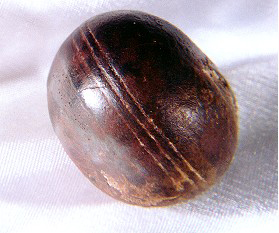
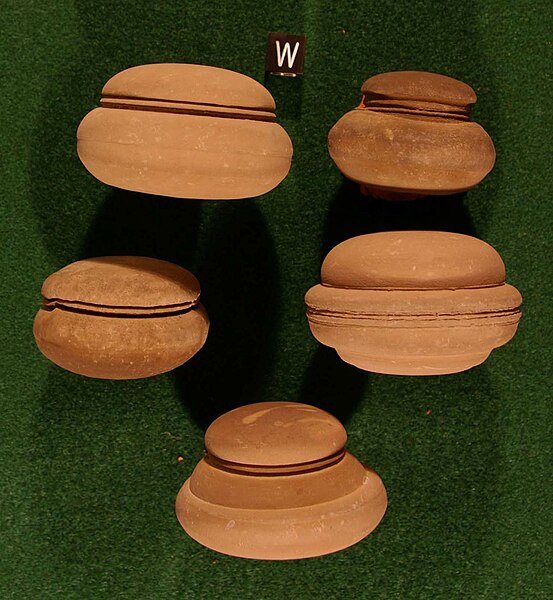
Credit: Wikipedia
The Iron pillar of Delhi: Iron pillar of Delhi: supposedly demonstrates more advanced metallurgy than was available in 1st millennium India.
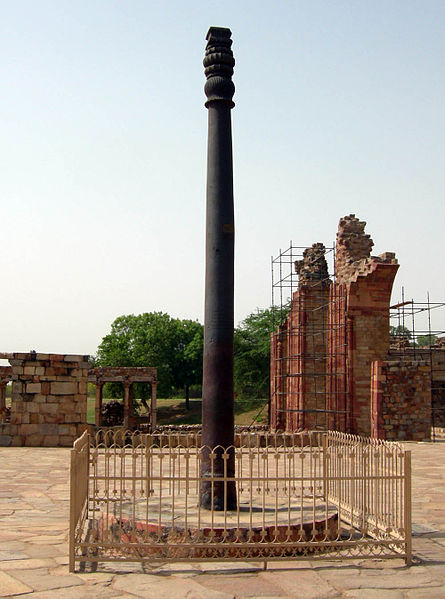
Credit: Photograph taken by Mark A. Wilson (Department of Geology, The College of Wooster)
One of Quimbaya airplanes. The Quimbaya civilization is a South American civilization, noted for spectacular gold work characterized by technical accuracy and detailed designs. The majority of the gold work is made in tumbaga alloy, with 30% copper, which imparts beautiful color tonalities to the pieces. The Quimbaya inhabited the areas corresponding the modern departments of Quindío, Caldas and Risaralda in Colombia, around the valley of the Cauca River. There is no clear data about when they were initially established; the current best guess is around the 1st century BCE.
Quimbaya airplanes: golden objects founded in Colombia, made by Quimbaya civilization culture, that are supposed to represent modern airplanes. In the Gold Museum, Bogota they are described as figures of birds and insects. However, many researchers doubt this determination.

Credit: Nemequene
Inca Stone
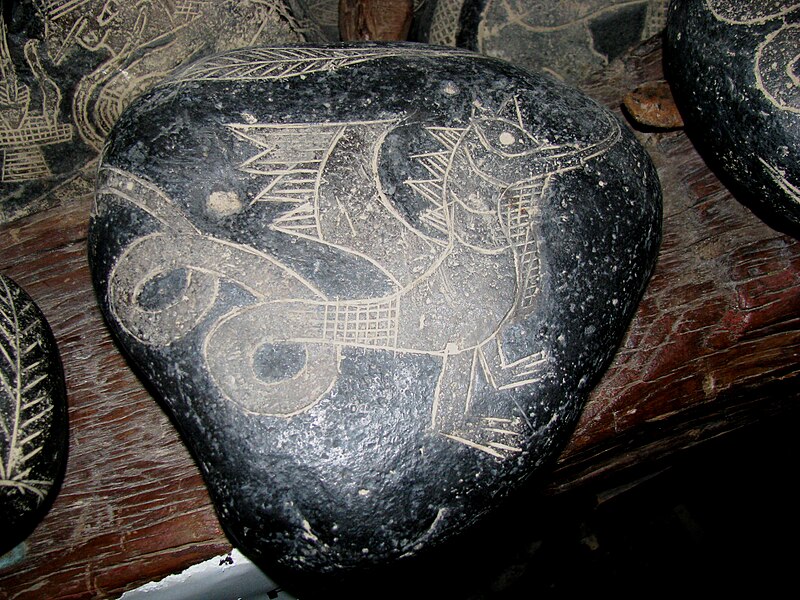
Credit: Brattarb
Baalbek megaliths: Supposedly impossible to move with Bronze Age technology.
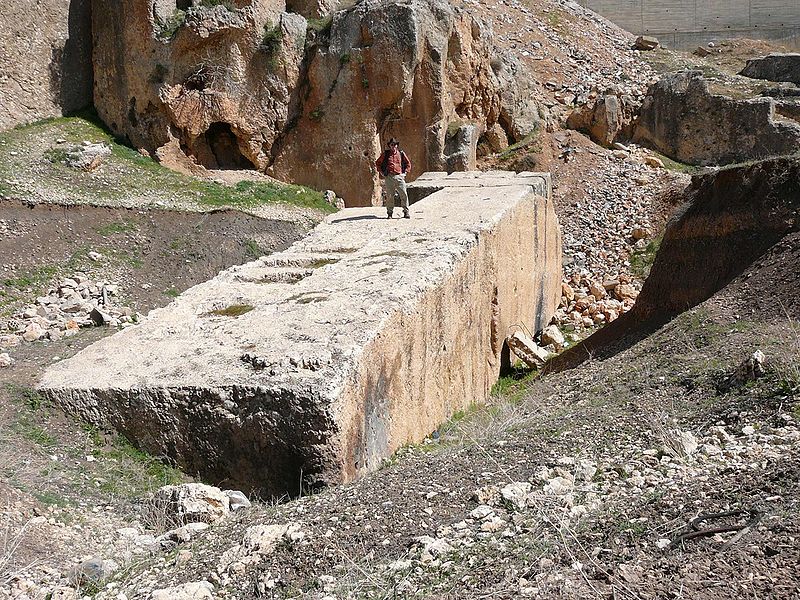
Credit: Wikipedia
The Temple complex at Baalbeck

Credit: Wikipedia
In rare cases, a claim is validated by mainstream science; i.e., it is proven that some artifact was created with a technology not previously thought to have existed in the ancient culture that built it. One piece that changed mainstream understanding of ancient technology is the Antikythera mechanism, a type of mechanical computer which has been fully validated as a real object from about 150–100 BCE. Before X-ray examination, its clockwork-like appearance (dating about 1,000 years before clocks were invented) was cited as evidence of alien visitation by fringe sources.
Antikythera mechanism and a schematic of the mechanism.
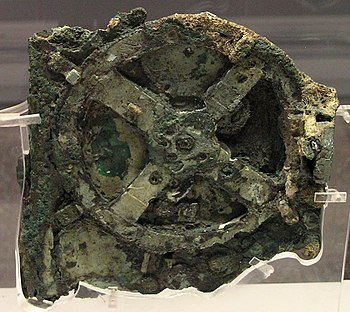

A partially validated example is the Maine penny, from the Goddard site in Blue Hill, Maine, United States. It is an 11th century Norse coin found in an American Indian shell midden. Over 20,000 objects were found over a 15-year period at the site. The sole non-Native artifact was the coin. Some argue it demonstrates Norse visits to North America unknown to archaeology; mainstream belief is that it was brought to the site from Labrador or Newfoundland by native trade
Dendera Lamps: supposed to depict a light bulb, but made in Ptolemaic Egypt.: The “Dendera light” is a technology of electrical lighting supposedly in existence in ancient Egypt, proposed by some authors. Proponents argue that the technology is depicted in the Hathor temple at the Dendera Temple complex located in Egypt on three stone reliefs (one single and a double representation), which resemble some modern electrical lighting systems. Egyptologists reject the theory and explain the reliefs as a typical set of symbolic images from Egyptian mythology

Iron Man (Eiserner Mann): an old iron pillar, said to be a unique oddity in Central Europe. Der Eiserne Mann (The Iron Man) is an old iron pillar partially buried in the ground in the German national forest of Naturpark Kottenforst-Ville, about two kilometers north-east of the village Dünstekoven. It is a roughly square metal bar with about 1.47 m above ground and approximately 2.7 m below ground. The pillar is currently located at a meeting of trails which were built in the early 18th century through the formerly pathless forest area, but it is believed to have stood in another nearby location before that time.

Credit: Chris Walters
After the long exposure to the weather, the iron man shows signs of weathering but there is remarkably little trace of rust. It is located at 50.70757° N by 6.96105° E at an elevation of approximately 159 m.
Nazca Lines: supposedly impossible to design without the aid of an aerial view. The Nazca Lines are a series of ancient geoglyphs located in the Nazca Desert in southern Peru. They were designated as a UNESCO World Heritage Site in 1994. The high, arid plateau stretches more than 80 kilometres (50 mi) between the towns of Nazca and Palpa on the Pampas de Jumana about 400 km south of Lima. Although some local geoglyphs resemble Paracas motifs, scholars believe the Nazca Lines were created by the Nazca culture between 400 and 650 AD.[1] The hundreds of individual figures range in complexity from simple lines to stylized hummingbirds, spiders, monkeys, fish, sharks, orcas, and lizards.
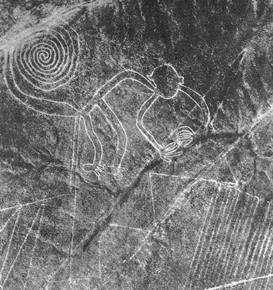
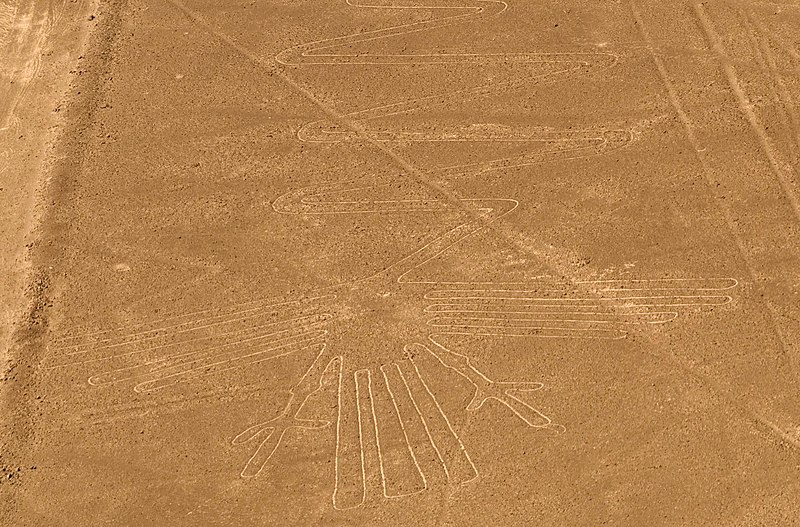

Pacal’s sarcophagus lid: Described by Erich von Däniken as a depiction of a spaceship.

Piri Reis map: several ancient astronauts authors, and others such as Gavin Menzies and Charles Hapgood, suggested that this map, made by the Turkish admiral Piri Reis from a diverse range of sources centuries before Antarctica was discovered, features that continent and even has many points of continuity with modern maps of Antarctica below its ice sheets.
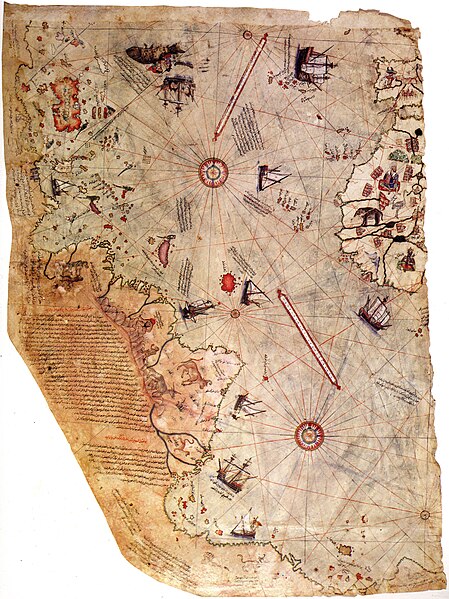
Saqqara Bird: supposed to depict a glider, but made in Ancient Egypt.: Some have suggested that the Saqqara Bird may represent evidence that knowledge of the principles of aviation existed many centuries before such are generally believed to have first been discovered. Egyptian physician, archaeologist, parapsychologist and dowser Khalil Messiha has speculated that the ancient Egyptians developed the first aircraft. He wrote that it “represents a diminutive of an original monoplane still present in Saqqara.” He also claimed that the Saqqara Bird could function as a glider if it had a horizontal tailplane, which he “suppose[d] was lost,”[5] and noted that the Egyptians often placed miniaturized representations of their technology in their tomb
Messiha contended that the Saqqara Bird differs significantly from other statues and models of birds housed in the Cairo museum. According to Messiha, the Saqqara Bird has a vertical tailplane which is unlike the generally horizontal shape of a real bird’s tail. Richard P. Hallion described this fin as “shaped as if the bird had twisted its tail feathers.” It is also legless and has wings set at an angle Messiha sees as similar to that of modern aircraft, which he considered an attempt to create aerodynamic lift.

Shakōkidogū: small humanoid and animal figurines made during the late Jōmon period (14,000 –400 BCE) of prehistoric Japan, said to resemble extraterrestrial astronauts.
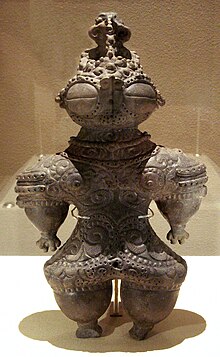


Stone spheres of Costa Rica: inaccurately described as perfectly spherical, and therefore as demonstrating greater stoneworking skills than were available in pre-Columbian times.The stone spheres (or stone balls) of Costa Rica are an assortment of over three hundred petrospheres in Costa Rica, located on the Diquís Delta and on Isla del Caño. Locally, they are known as Las Bolas. The spheres are commonly attributed to the extinct Diquís culture and are sometimes referred to as the Diquís Spheres. They are the best-known stone sculptures of the Isthmo-Colombian area.
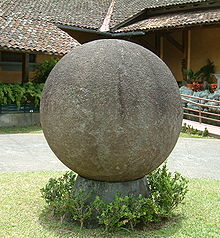

The Cambodian stegasaurus is found in the carved facade seen at the temples of Ta Prohm, Cambodia and are dated to the 11th century A.D.


Credit: http://www.bible.ca/tracks/tracks-cambodia.htm
The Baigong Pipes are a series of pipe-like features found on and near Mount Baigong, about 40 km southwest of the city of Delingha, in the Haixi Mongol and Tibetan Autonomous Prefecture, Qinghai Province, China.The Baigong Pipes are reported to be associated with a “pyramid” about 50 to 60 meters (160 to 200 feet) high built on Mount Baigong. The front of the “pyramid” reportedly contains three caves. The mouths of the two smaller caves have collapsed. Only the largest cave, which is 6 meters (18 feet) high, can be entered

Credit: Wikipedia
Cylindrical structures very similar to the Baigong Pipes have also been found protruding from outcrops of Pliocene Citronelle Formation in the Florida parishes of Louisiana and in older Pleistocene fluvial sediments within South-central Louisiana. These structures are as much as 70 cm in diameter and 100 cm in depth. Detailed studies of these cylindrical structures found that they were created by the formation of ironstone rims around tap roots of pine trees by soil forming processes Natural pipe-like features, which are virtually identical to the Baigong Pipes, occur in the Navajo Sandstone and other sandstones of Southwestern United States. The bleached sandstone seen in the picture of the cave entrance is typical of sandstones in which natural pipe-like features have been found.
Two Baigong Pipes have been reported from the largest cave. One of these is described as being 40 cm (16 in) in diameter and preserved as a reddish-brown “half-pipe”. Within the same cave, another pipe-like feature of similar diameter was also found. “Dozens” of upright pipe-like features, about 10 to 40 cm (4 to 16 inches) in diameter, were also found protruding from Mount Baigong above the largest cave.
Additional Baigong Pipes were found on shore and within Toson Lake, which lies 80 meters (260 feet) from the mouth of the largest cave. On the beach of Lake Toson, about 40 meters (130 feet) from the mouth of the largest cave, apparently flat-lying, hollow, pipe-like features were found. These reddish-brown pipe-like features range in diameter from 2 to 4.5 cm (0.8 to 1.8 inch) and have an east-west orientation. Another group of pipe-like features, presumably vertical, either protrude from or lie just below the surface of the lake.
Associated with these pipe-like features are “rusty scraps” and “strangely shaped stones”. Analysis of the “rusty scraps” by Liu Shaolin at a “local smeltery” reportedly found that they consist of 30 percent ferric oxide and large amounts of silicon dioxide and calcium oxide. Because any metallurgical analysis reports the composition of a material analyzed, not in terms of the actual minerals comprising it, but only in terms of percentages of the oxides of the specific elements present, the calcium present in the “pipes” could have been in the form of calcite, a mineral that naturally forms concretions.
Abydos Temple: Abydos is one of the most ancient cities of Upper Egypt, and also of the eight Upper Nome, of which it was the capital city. It is located about 11 kilometres (6.8 mi) west of the Nile at latitude 26° 10′ N, near the modern Egyptian towns of el-’Araba el Madfuna and al-Balyana. The city was called Abdju in the ancient Egyptian language (3bdw or AbDw as technically transcribed from hieroglyphs) meaning “the hill of the symbol or reliquary”, a reference to a reliquary in which the sacred head of Osiris was preserved. The Temple is also famous for a carving that shows what looks to be a helicopter, submarine, a flying saurcer and a jet aircraft.
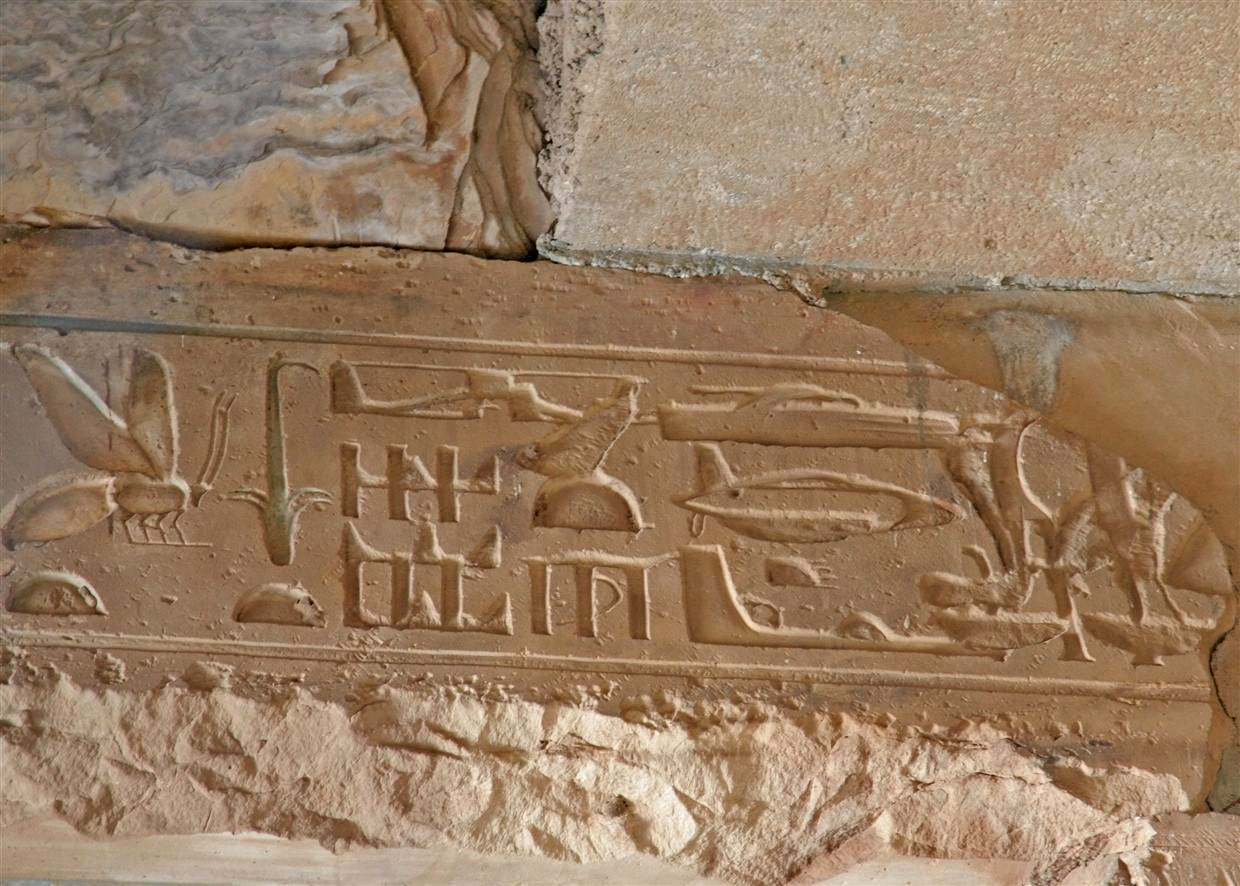
Considered one of the most important archaeological sites of Ancient Egypt, the sacred city of Abydos was the site of many ancient temples, including Umm el-Qa’ab, a royal necropolis where early pharaohs were entombed. These tombs began to be seen as extremely significant burials and in later times it became desirable to be buried in the area, leading to the growth of the town’s importance as a cult site.
Today, Abydos is notable for the memorial temple of Seti I, which contains an inscription from the nineteenth dynasty known to the modern world as the Abydos King List. It is a chronological list showing cartouches of most dynastic pharaohs of Egypt from Menes until Ramesses I, Seti’s father. The Great Temple and most of the ancient town are buried under the modern buildings to the north of the Seti temple. Many of the original structures and the artifacts within them are considered irretrievable and lost; many may have been destroyed by the new construction.
Chief Joseph and the Cuneiform Tablet
Among the effects of Chief Joseph, the famed leader of the Nez Perce Indians, was a clay tablet bearing a cuneiform inscription. The tablet transmits no startling message, being merely a receipt for one lamb changing hands. But where did a Northwest Indian chief get a 3,000year-old tablet? The tablet first came to light around 1878, long before cuneiform tablets became common on the artifacts market. Still, it could have been a gift from some missionary or tourist — or even planted as a hoax.

(Park, Edwards; “Where Did Chief Joseph Get a Cuneiform Tablet?” Smithsonian Magazine, 9:36, February 1979.)
Ancient Roman pottery off Maine: While skindiving in the Bay of Castine in 1971, Norman Bakeman discovered two peculiar ceramic storage jars in 12 meters of water. These jars were recovered and have since been compared to Portugese “anforetas” used during the Roman period for the storage of wine, oil, honey, etc. A similar anforeta as also been recovered in Jonesboro, Maine. The clay paste and grit of the Maine jars closely resemble those used in Iberia almost 2,000 years ago. The possibility that these containers might be Spanish olive jars circa 1800 is also discussed.
Anforetas
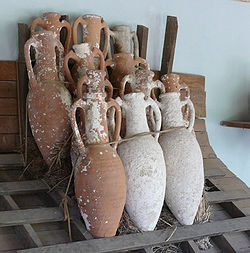
(Whittall, James P., II; “Anforetas Recovered in Maine,” Early Sites Research Society, Bulletin, 5:1, 1977.) as reported by William Corliss, Science Frontiers.
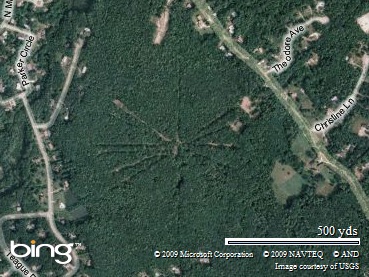
Credit: http://mikenh.wordpress.com/2009/10/22/marker-72-mystery-hill/
Saudi Arabia Has Nazca Like Lines, Strange Stone Circles, Huge Craters And Incredible Crescent Moon Only Visible From The Airhttp://tiny.cc/jcs4lw The Arabia Shield has a volcanic nature inside. A region of the Western Saudi Arabia is in

Hueyatlaco: 250,000 Year Old Settlement In Mexico Found Under Volcanic Ash http://tiny.cc/ndt4lw
Humans were hunting mastodons in Mexico 250,000 years ago. This archaeological heresy is supported by finding at Hueyatlaco.
Hueyatlaco is an archeological site in Valsequillo, Mexico. Several potential pre-Clovis localities were found in the 1960s around the edge of the Valsequillo Reservoir, Mexico. One of these localities is the site of Hueyatlaco. This site was excavated by Cynthia Irwin-Williams in 1962, 1964, and 1966.

Bron:
Ook het bericht over de Chinese piramides sluit hier mooi op aan!
► http://thisisyourwake-upcall.blogspot.nl/2011/12/alien-base-found-at-chinese-pyramid.html
Forbidden Archaeology – Secret Discoveries of Early Man
Out-of-place artifact (OOPArt) is a term coined by American naturalist and cryptozoologist Ivan T. Sanderson for an object of historical, archaeological, or paleontological interest found in a very unusual or seemingly impossible context that could challenge conventional historical chronology.
The term “out-of-place artifact” is rarely used by mainstream historians or scientists. Its use is largely confined to cryptozoologists, proponents of ancient astronaut theories, Young Earth creationists, and paranormal enthusiasts. The term is used to describe a wide variety of objects, from anomalies studied by mainstream science to pseudoarchaeology far outside the mainstream, to objects that have been shown to be hoaxes or to have mundane explanations.
Critics argue that most purported OOPArts which are not hoaxes are the result of mistaken interpretation, wishful thinking, or a mistaken belief that a particular culture couldn’t have created an artifact or technology due to a lack of knowledge or materials. Supporters regard OOPArts as evidence that mainstream science is overlooking huge areas of knowledge, either willfully or through ignorance.
Many writers or researchers who question conventional views of human history have used purported OOPArts in attempts to bolster their arguments. Creation Science relies on allegedly anomalous finds in the archaeological record to challenge scientific chronologies and models of human evolution. Claimed OOPArts have been used to support religious descriptions of pre-history, ancient astronaut theories, or the notion of vanished civilizations that possessed knowledge or technology more advanced than our own.
Uploaded by UFOTVstudios Subscribe to this channel here: http://www.youtube.com/show/ufotvpresents
It’s Indiana Jones meets The X-Files in this intriguing program that tackles the age-old question “Where did we come from?” Fascinating viewing! Highly recommended! – Michael Rogers, “Library Journal”
The creators of the Emmy Award Winning Mystery of the Sphinx present a revolutionary new film that examines one of our greatest mysteries: Man’s origins. Hosted by Charlton Heston, this film challenges what we are being taught about human evolution and the rise of early civilization. A new breed of scientific investigators present startling evidence that the academic community has quietly ignored.
The creators of the Emmy Award Winning Mystery of the Sphinx present a revolutionary new film that examines one of our greatest mysteries: Man’s origins. Hosted by Charlton Heston, this film challenges what we are being taught about human evolution and the rise of early civilization. A new breed of scientific investigators present startling evidence that the academic community has quietly ignored.
Footprint resembling man discovered along side dinosaur tracks.


Credit: http://www.UFOTV.com. and Bushnev, Alexander, Komsomolskya Pravda, January 31, 1995,
This footprint is from the Zapata track, found in Permian limestone in New Mexico. In 1987, not far from the Zapata track site, paleontologist Jerry MacDonald discovered a variety of beautifully preserved fossil footprints in Permian strata. The Robledo Mountain site contains thousands of footprints and invertebrate trails that represent dozens of different kinds of animals.

Credit: http://www.ancient-wisdom.co.uk/ooparts.htm /”Petrified Footprints: A Puzzling Parade of Permian Beasts,” The Smithsonian, Vol. 23, July 1992, p.70
In some cases, the uncertainty results from inaccurate descriptions. For example: the Wolfsegg Iron was said to be a perfect cube, but in fact it is not; the Klerksdorp spheres were said to be perfect spheres, but they are not; and the Iron pillar of Delhi was said to be stainless, but it has some rust near its base.
Klerksdorp spheres are small objects, often spherical to disc-shaped, that have been collected by miners and rockhounds from 3-billion-year-old pyrophyllite deposits mined by Wonderstone Ltd., near Ottosdal, South Africa. They have been cited by some alternative researchers and reporters in books, popular articles, and many web pages, as inexplicable out-of-place artifacts that could only have been manufactured by intelligent beings. Geologists who have studied these objects argue that the objects are not manufactured, but are rather the result of natural processes


Credit: Wikipedia
The Iron pillar of Delhi: Iron pillar of Delhi: supposedly demonstrates more advanced metallurgy than was available in 1st millennium India.

Credit: Photograph taken by Mark A. Wilson (Department of Geology, The College of Wooster)
One of Quimbaya airplanes. The Quimbaya civilization is a South American civilization, noted for spectacular gold work characterized by technical accuracy and detailed designs. The majority of the gold work is made in tumbaga alloy, with 30% copper, which imparts beautiful color tonalities to the pieces. The Quimbaya inhabited the areas corresponding the modern departments of Quindío, Caldas and Risaralda in Colombia, around the valley of the Cauca River. There is no clear data about when they were initially established; the current best guess is around the 1st century BCE.
Quimbaya airplanes: golden objects founded in Colombia, made by Quimbaya civilization culture, that are supposed to represent modern airplanes. In the Gold Museum, Bogota they are described as figures of birds and insects. However, many researchers doubt this determination.

Credit: Nemequene
Inca Stone

Credit: Brattarb
Baalbek megaliths: Supposedly impossible to move with Bronze Age technology.

Credit: Wikipedia
The Temple complex at Baalbeck

Credit: Wikipedia
In rare cases, a claim is validated by mainstream science; i.e., it is proven that some artifact was created with a technology not previously thought to have existed in the ancient culture that built it. One piece that changed mainstream understanding of ancient technology is the Antikythera mechanism, a type of mechanical computer which has been fully validated as a real object from about 150–100 BCE. Before X-ray examination, its clockwork-like appearance (dating about 1,000 years before clocks were invented) was cited as evidence of alien visitation by fringe sources.
Antikythera mechanism and a schematic of the mechanism.


A partially validated example is the Maine penny, from the Goddard site in Blue Hill, Maine, United States. It is an 11th century Norse coin found in an American Indian shell midden. Over 20,000 objects were found over a 15-year period at the site. The sole non-Native artifact was the coin. Some argue it demonstrates Norse visits to North America unknown to archaeology; mainstream belief is that it was brought to the site from Labrador or Newfoundland by native trade
Dendera Lamps: supposed to depict a light bulb, but made in Ptolemaic Egypt.: The “Dendera light” is a technology of electrical lighting supposedly in existence in ancient Egypt, proposed by some authors. Proponents argue that the technology is depicted in the Hathor temple at the Dendera Temple complex located in Egypt on three stone reliefs (one single and a double representation), which resemble some modern electrical lighting systems. Egyptologists reject the theory and explain the reliefs as a typical set of symbolic images from Egyptian mythology

Iron Man (Eiserner Mann): an old iron pillar, said to be a unique oddity in Central Europe. Der Eiserne Mann (The Iron Man) is an old iron pillar partially buried in the ground in the German national forest of Naturpark Kottenforst-Ville, about two kilometers north-east of the village Dünstekoven. It is a roughly square metal bar with about 1.47 m above ground and approximately 2.7 m below ground. The pillar is currently located at a meeting of trails which were built in the early 18th century through the formerly pathless forest area, but it is believed to have stood in another nearby location before that time.

Credit: Chris Walters
After the long exposure to the weather, the iron man shows signs of weathering but there is remarkably little trace of rust. It is located at 50.70757° N by 6.96105° E at an elevation of approximately 159 m.
Nazca Lines: supposedly impossible to design without the aid of an aerial view. The Nazca Lines are a series of ancient geoglyphs located in the Nazca Desert in southern Peru. They were designated as a UNESCO World Heritage Site in 1994. The high, arid plateau stretches more than 80 kilometres (50 mi) between the towns of Nazca and Palpa on the Pampas de Jumana about 400 km south of Lima. Although some local geoglyphs resemble Paracas motifs, scholars believe the Nazca Lines were created by the Nazca culture between 400 and 650 AD.[1] The hundreds of individual figures range in complexity from simple lines to stylized hummingbirds, spiders, monkeys, fish, sharks, orcas, and lizards.



Pacal’s sarcophagus lid: Described by Erich von Däniken as a depiction of a spaceship.

Piri Reis map: several ancient astronauts authors, and others such as Gavin Menzies and Charles Hapgood, suggested that this map, made by the Turkish admiral Piri Reis from a diverse range of sources centuries before Antarctica was discovered, features that continent and even has many points of continuity with modern maps of Antarctica below its ice sheets.

Saqqara Bird: supposed to depict a glider, but made in Ancient Egypt.: Some have suggested that the Saqqara Bird may represent evidence that knowledge of the principles of aviation existed many centuries before such are generally believed to have first been discovered. Egyptian physician, archaeologist, parapsychologist and dowser Khalil Messiha has speculated that the ancient Egyptians developed the first aircraft. He wrote that it “represents a diminutive of an original monoplane still present in Saqqara.” He also claimed that the Saqqara Bird could function as a glider if it had a horizontal tailplane, which he “suppose[d] was lost,”[5] and noted that the Egyptians often placed miniaturized representations of their technology in their tomb
Messiha contended that the Saqqara Bird differs significantly from other statues and models of birds housed in the Cairo museum. According to Messiha, the Saqqara Bird has a vertical tailplane which is unlike the generally horizontal shape of a real bird’s tail. Richard P. Hallion described this fin as “shaped as if the bird had twisted its tail feathers.” It is also legless and has wings set at an angle Messiha sees as similar to that of modern aircraft, which he considered an attempt to create aerodynamic lift.

Shakōkidogū: small humanoid and animal figurines made during the late Jōmon period (14,000 –400 BCE) of prehistoric Japan, said to resemble extraterrestrial astronauts.





The Cambodian stegasaurus is found in the carved facade seen at the temples of Ta Prohm, Cambodia and are dated to the 11th century A.D.


Credit: http://www.bible.ca/tracks/tracks-cambodia.htm
The Baigong Pipes are a series of pipe-like features found on and near Mount Baigong, about 40 km southwest of the city of Delingha, in the Haixi Mongol and Tibetan Autonomous Prefecture, Qinghai Province, China.The Baigong Pipes are reported to be associated with a “pyramid” about 50 to 60 meters (160 to 200 feet) high built on Mount Baigong. The front of the “pyramid” reportedly contains three caves. The mouths of the two smaller caves have collapsed. Only the largest cave, which is 6 meters (18 feet) high, can be entered

Credit: Wikipedia
Cylindrical structures very similar to the Baigong Pipes have also been found protruding from outcrops of Pliocene Citronelle Formation in the Florida parishes of Louisiana and in older Pleistocene fluvial sediments within South-central Louisiana. These structures are as much as 70 cm in diameter and 100 cm in depth. Detailed studies of these cylindrical structures found that they were created by the formation of ironstone rims around tap roots of pine trees by soil forming processes Natural pipe-like features, which are virtually identical to the Baigong Pipes, occur in the Navajo Sandstone and other sandstones of Southwestern United States. The bleached sandstone seen in the picture of the cave entrance is typical of sandstones in which natural pipe-like features have been found.
Two Baigong Pipes have been reported from the largest cave. One of these is described as being 40 cm (16 in) in diameter and preserved as a reddish-brown “half-pipe”. Within the same cave, another pipe-like feature of similar diameter was also found. “Dozens” of upright pipe-like features, about 10 to 40 cm (4 to 16 inches) in diameter, were also found protruding from Mount Baigong above the largest cave.
Additional Baigong Pipes were found on shore and within Toson Lake, which lies 80 meters (260 feet) from the mouth of the largest cave. On the beach of Lake Toson, about 40 meters (130 feet) from the mouth of the largest cave, apparently flat-lying, hollow, pipe-like features were found. These reddish-brown pipe-like features range in diameter from 2 to 4.5 cm (0.8 to 1.8 inch) and have an east-west orientation. Another group of pipe-like features, presumably vertical, either protrude from or lie just below the surface of the lake.
Associated with these pipe-like features are “rusty scraps” and “strangely shaped stones”. Analysis of the “rusty scraps” by Liu Shaolin at a “local smeltery” reportedly found that they consist of 30 percent ferric oxide and large amounts of silicon dioxide and calcium oxide. Because any metallurgical analysis reports the composition of a material analyzed, not in terms of the actual minerals comprising it, but only in terms of percentages of the oxides of the specific elements present, the calcium present in the “pipes” could have been in the form of calcite, a mineral that naturally forms concretions.
Abydos Temple: Abydos is one of the most ancient cities of Upper Egypt, and also of the eight Upper Nome, of which it was the capital city. It is located about 11 kilometres (6.8 mi) west of the Nile at latitude 26° 10′ N, near the modern Egyptian towns of el-’Araba el Madfuna and al-Balyana. The city was called Abdju in the ancient Egyptian language (3bdw or AbDw as technically transcribed from hieroglyphs) meaning “the hill of the symbol or reliquary”, a reference to a reliquary in which the sacred head of Osiris was preserved. The Temple is also famous for a carving that shows what looks to be a helicopter, submarine, a flying saurcer and a jet aircraft.

Considered one of the most important archaeological sites of Ancient Egypt, the sacred city of Abydos was the site of many ancient temples, including Umm el-Qa’ab, a royal necropolis where early pharaohs were entombed. These tombs began to be seen as extremely significant burials and in later times it became desirable to be buried in the area, leading to the growth of the town’s importance as a cult site.
Today, Abydos is notable for the memorial temple of Seti I, which contains an inscription from the nineteenth dynasty known to the modern world as the Abydos King List. It is a chronological list showing cartouches of most dynastic pharaohs of Egypt from Menes until Ramesses I, Seti’s father. The Great Temple and most of the ancient town are buried under the modern buildings to the north of the Seti temple. Many of the original structures and the artifacts within them are considered irretrievable and lost; many may have been destroyed by the new construction.
Chief Joseph and the Cuneiform Tablet
Among the effects of Chief Joseph, the famed leader of the Nez Perce Indians, was a clay tablet bearing a cuneiform inscription. The tablet transmits no startling message, being merely a receipt for one lamb changing hands. But where did a Northwest Indian chief get a 3,000year-old tablet? The tablet first came to light around 1878, long before cuneiform tablets became common on the artifacts market. Still, it could have been a gift from some missionary or tourist — or even planted as a hoax.

(Park, Edwards; “Where Did Chief Joseph Get a Cuneiform Tablet?” Smithsonian Magazine, 9:36, February 1979.)
Rameses Hooked on Tobacco:: French scientists examining the stomach of the Egyptian Pharaoh Rameses II found fragments of tobacco leaves. Further analysis of the 3,200-year-old mummy indicated the presence of nicotine in the body. Conventional wisdom has it that tobacco was unknown in the Old World until the Spanish brought it back from the Americas in the Sixteenth Century.
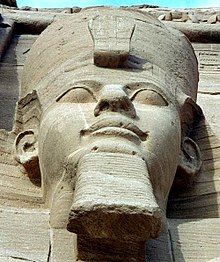
(Anonymous; “Tobacco in Egypt,” Anthropological Journal of Canada, 16:10, 1978.)
Ancient Roman pottery off Maine: While skindiving in the Bay of Castine in 1971, Norman Bakeman discovered two peculiar ceramic storage jars in 12 meters of water. These jars were recovered and have since been compared to Portugese “anforetas” used during the Roman period for the storage of wine, oil, honey, etc. A similar anforeta as also been recovered in Jonesboro, Maine. The clay paste and grit of the Maine jars closely resemble those used in Iberia almost 2,000 years ago. The possibility that these containers might be Spanish olive jars circa 1800 is also discussed.
Anforetas

(Whittall, James P., II; “Anforetas Recovered in Maine,” Early Sites Research Society, Bulletin, 5:1, 1977.) as reported by William Corliss, Science Frontiers.
Mystery Hill, Town of Salem, NH
Four miles east on Route 111 is a privately owned complex of strange stone structures bearing similarities to early stone work found in western Europe. They suggest an ancient culture may have existed here more than 2,000 years ago. Sometimes called “America’s Stonehenge”, these intriguing chambers hold a fascinating story and could be remnants of a pre-Viking or even Phoenician civilization.
Credit: http://mikenh.wordpress.com/2009/10/22/marker-72-mystery-hill/
Saudi Arabia Has Nazca Like Lines, Strange Stone Circles, Huge Craters And Incredible Crescent Moon Only Visible From The Airhttp://tiny.cc/jcs4lw The Arabia Shield has a volcanic nature inside. A region of the Western Saudi Arabia is in
fact covered with vast fields of lava known as harraat. These lands are spotted by many stone circles, Nazca-like lines and other quite interesting archaeological remains of the Neolithic period, such as the “desert kites”, the hunters used to guide the game across the harrah in some corrals. With Google Maps, Italian researcher Amelia Carolina Sparavigna and others at the Dipartimento di Fisica, Politecnico di Torino were able observe both sceneries, the volcanic nature of the land and a portrait of Arabia during the Neolithic times. Locations are given so others can find them on Google Earth. Part of Figure 4: Nazca-like lines, desert kits and strange stone circles in Saudi Arabia

Nine photos and story here: http://tiny.cc/jcs4lw
Humans were hunting mastodons in Mexico 250,000 years ago. This archaeological heresy is supported by finding at Hueyatlaco.
Hueyatlaco is an archeological site in Valsequillo, Mexico. Several potential pre-Clovis localities were found in the 1960s around the edge of the Valsequillo Reservoir, Mexico. One of these localities is the site of Hueyatlaco. This site was excavated by Cynthia Irwin-Williams in 1962, 1964, and 1966.

Bron:

Geen opmerkingen:
Een reactie posten